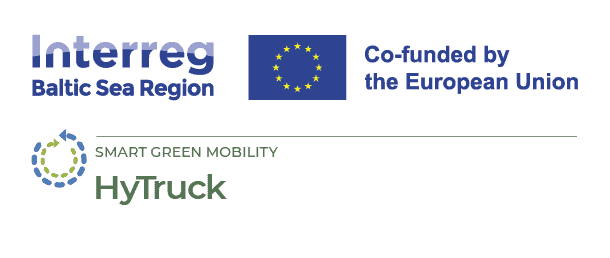
Slope matters: Thermal management of fuel-cell electric heavy-duty vehicles and geospatial distribution of HRS
07 April 2025
The 19th HyTruck Breakfast Briefing was held on 2nd April 2025 with approximately 45 participants present during the meeting.
The speakers for the event were arranged by HyTruck partner Chalmers University of Technology in Gothenburg Sweden. The event was hosted by Maria Grahn, Associate Professor, from the division of Transport, Energy and Environment, under department of Mechanics and Maritime Sciences. Both speakers, Christian Boßer and Joel Löfving, were from the division of Transport, Energy and Environment and currently do their research in the TechForH2 competence center. TechForH2 aims to develop new technology in hydrogen propulsion in heavy duty transport.
Mr. Boßer’s research focuses on the development and integration of fuel cell technology in heavy duty vehicles. The aim is to replace traditional engines with electrochemical hydrogen conversion using Proton exchange membrane (PEM). The research has three key objectives.
- Optimizing fuel cell operation: PEM fuel cells have a high energy density and are fast to refuel. The challenges regarding PEM are related to cost, lifetime and the thermal management of the fuel cell. PEM fuel cells operate most efficiently between 60 °C and 80 °C, with short-term peak temperatures up to 90 °C.
- Thermal management: Excessive heat can degrade the fuel cell’s lifetime. To prevent this effective and innovative cooling solutions are needed, especially in high temperature environments and during demanding conditions such as hill climbs. The cooling techniques in the research utilize water evaporation to transfer excess heat out of the fuel cell.
- The Heavy-Duty Truck Model: The research has led to the development of a heavy-duty truck model. The model includes two fuel cell stacks, a separate cooling loop and other auxiliary components. This model can be used to simulate real-world scenarios and identify limitations to the cooling system. The aim is to create a heavy-duty truck that can perform optimally under various conditions. Once this model is created, it will be verified with the truck manufacturer.
The future work in the project will aim to create a fuel cell test bench and validate the advanced fuel cell models. Ultimately, the fuel cells should be transferable to heavy-duty transport vehicles.
Mr. Löfving currently researches the geospatial distribution of hydrogen demand and designing the refueling infrastructure for long-haul trucks in Europe. The research aims to ensure the accuracy of infrastructure. The completed infrastructure should have adequate production and distribution capacity to respond to demand.
The refueling and consumption has been simulated by the Simulating Vehicle Energy Needs Geographically (SVENG) model developed in the project. Flow data is used to simulate the energy needs of vehicles across the continent. The model is scalable and able to handle large networks and logistics flows without increasing computational requirements.
In the core of the research are long-haul trucks that operate along 600 000 routes all over Europe, each over 360 kilometers. The routes consist of nodes and links between them. The model is able to analyze the inclinations, velocities and vehicle power dynamics to create estimates of hydrogen demand along the routes. This approach can provide an accurate model of hydrogen demand than models that utilize average energy consumption. By this model the areas where refueling stations are most needed can be identified.
The simulated refueling infrastructure will be compared with the Alternative Fuel Infrastructure Regulation (AFIR) requirements for 2030 and 2050. So far the findings in the project suggest that some countries might need significantly more refueling infrastructure than previously expected. On the other hand, some countries might not require the mandated capacity, even by 2050.
The network data from the research will be released and thus it will be available for other infrastructure assessments. This will contribute to a broader understanding of hydrogen demand and refueling needs across Europe.
The next HyTruck Breakfast Briefing meeting will be held on Monday the 5th of May at 11:00 CET. Note the exceptional time of the event. The event will be hosted by the lead partner of HyTruck project, Ministry of Economics, Infrastructure, Tourism and Labour Mecklenburg-Vorpommern. The topic confirmed so far is related to another Interreg project, Green Industrial Areas.
Mr. Todorov also mentioned the available hybrid event on the 10th of April regarding the future of heavy duty vehicles: https://events.euractiv.com/event/info/heavy-duty-vehicles-what-future-in-europes-automotive-sector





